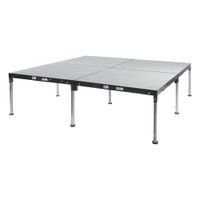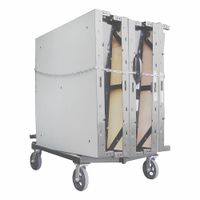Call +(254) 703 030 000 / 751 483 999 / 721 704 777
Frequently Asked Questions
What are the different types of portable stages available?
Portable stages come in various types, each designed to meet specific needs and settings. Here are some common types:
1. **Folding Stages**: These are compact and easy to set up, often used in schools and small venues. They typically have a foldable frame and platform, making them easy to transport and store.
2. **Modular Stages**: Composed of multiple sections that can be assembled in various configurations, modular stages offer flexibility in size and shape. They are ideal for events requiring custom layouts.
3. **Riser Stages**: These are elevated platforms used to raise performers or speakers above the audience. They can be adjusted in height and are often used in choirs, bands, and presentations.
4. **Rolling Stages**: Equipped with wheels, these stages can be easily moved from one location to another. They are suitable for events that require quick setup and teardown.
5. **Adjustable Stages**: These stages allow for height adjustments, making them versatile for different performance needs. They are often used in venues with varying audience sizes and sightlines.
6. **Outdoor Stages**: Designed to withstand weather conditions, these stages are typically more robust and may include features like weatherproofing and anchoring systems. They are used for concerts, festivals, and other outdoor events.
7. **Staging Platforms**: These are simple, flat platforms that can be used alone or combined with other platforms to create a larger stage. They are versatile and can be used in various settings.
8. **Truss Stages**: Incorporating truss systems, these stages are often used for larger events that require lighting and sound equipment. They provide structural support for additional equipment.
Each type of portable stage offers unique benefits, making it important to choose based on the specific requirements of the event or venue.
How do you assemble and disassemble a portable stage?
To assemble a portable stage, first ensure you have all components: stage platforms, legs, connectors, and tools. Begin by laying out the platforms in the desired configuration. Attach the legs to each platform, ensuring they are securely fastened. Use connectors to join adjacent platforms, aligning them properly to avoid gaps. Check stability by gently pressing on the stage surface. Adjust leg heights if necessary to ensure a level surface. Secure any additional safety features like guardrails or skirting.
To disassemble, start by removing any guardrails or skirting. Detach the connectors between platforms. Carefully remove the legs from each platform, ensuring not to damage the components. Stack the platforms and legs neatly for storage. Ensure all connectors and tools are accounted for and stored properly.
What materials are commonly used in portable stage construction?
Portable stage construction commonly utilizes a variety of materials to ensure durability, ease of assembly, and transportability. Key materials include:
1. **Aluminum**: Widely used for the framework due to its lightweight nature, corrosion resistance, and strength. Aluminum trusses and frames provide structural support while being easy to handle and transport.
2. **Steel**: Often used in conjunction with aluminum for added strength, especially in load-bearing components. Steel is heavier but provides robustness and stability, making it suitable for larger stages.
3. **Plywood**: Commonly used for the stage decking. It offers a sturdy, flat surface for performers and equipment. Plywood is chosen for its strength, ease of cutting to size, and ability to withstand heavy loads.
4. **Composite Materials**: These include fiberglass or carbon fiber, which are sometimes used for decking or structural components. They offer high strength-to-weight ratios and are resistant to environmental factors.
5. **High-Density Polyethylene (HDPE)**: Used for stage surfaces or modular components. HDPE is durable, weather-resistant, and provides a non-slip surface, making it ideal for outdoor stages.
6. **Rubber or Foam Padding**: Often used under the stage surface to provide cushioning and reduce noise. This is particularly important for stages used in dance or theatrical performances.
7. **Fasteners and Connectors**: High-quality bolts, screws, and locking mechanisms are essential for securely assembling and disassembling the stage components.
8. **Paints and Coatings**: Protective coatings are applied to metal components to prevent rust and wear, while non-slip paints are used on stage surfaces for safety.
These materials are selected based on the specific requirements of the stage, such as load capacity, environmental conditions, and the type of events it will host.
How do you determine the right size and height for a portable stage?
To determine the right size and height for a portable stage, consider the following factors:
1. **Event Type and Purpose**: Identify the nature of the event (concert, conference, play) to determine the stage's functionality. A concert may require a larger stage for band equipment, while a conference might need a smaller one for speakers.
2. **Audience Size**: Estimate the number of attendees. Larger audiences require bigger stages to ensure visibility and accommodate performers or speakers.
3. **Venue Size and Layout**: Measure the available space in the venue. Ensure the stage fits comfortably without obstructing exits or pathways.
4. **Performance Requirements**: Consider the number of performers and their activities. Dance performances need more space for movement, while a solo speaker requires less.
5. **Height Considerations**:
- **Visibility**: Ensure the stage is high enough for the audience to see clearly. For seated audiences, a height of 1-2 feet is typical, while standing audiences may require 3-4 feet.
- **Safety**: Ensure the stage height is safe for performers, with railings if necessary for higher stages.
6. **Accessibility**: Include ramps or stairs for easy access, especially for performers with mobility issues.
7. **Equipment and Set Design**: Account for the space needed for equipment, props, and set pieces. Ensure the stage can support the weight and size of all items.
8. **Budget**: Balance the desired stage size and height with budget constraints, considering rental or purchase costs.
9. **Regulations and Permits**: Check local regulations for stage construction and height restrictions, and obtain necessary permits.
10. **Flexibility and Modularity**: Opt for modular stages that can be adjusted in size and height to suit different events and venues.
What accessories are available to enhance portable stage functionality?
Portable stages can be enhanced with a variety of accessories to improve functionality, safety, and aesthetics. Key accessories include:
1. **Stage Skirting**: Provides a finished look by covering the sides of the stage, hiding structural elements and storage underneath.
2. **Guardrails**: Essential for safety, especially on elevated stages, to prevent falls and ensure compliance with safety regulations.
3. **Stairs and Ramps**: Facilitate easy access to the stage for performers and equipment, with ramps being crucial for ADA compliance.
4. **Stage Extensions**: Allow for customization of stage size and shape, accommodating different performance needs and venue constraints.
5. **Backdrops and Curtains**: Enhance visual appeal and provide a professional appearance, while also serving as a background for performances.
6. **Lighting Systems**: Include spotlights, LED panels, and other lighting equipment to enhance visibility and create desired atmospheres.
7. **Sound Systems**: Portable PA systems, microphones, and speakers ensure clear audio delivery for performances and speeches.
8. **Stage Flooring**: Options like non-slip surfaces or specialized dance floors improve safety and performance quality.
9. **Weather Protection**: Canopies, tents, or roof systems protect performers and equipment from adverse weather conditions during outdoor events.
10. **Cable Management Systems**: Keep electrical and audio cables organized and out of the way to prevent tripping hazards.
11. **Transport and Storage Solutions**: Dollies, carts, and cases facilitate easy transport and storage of stage components.
12. **Custom Branding**: Banners, logos, and other branding elements can be added to promote sponsors or events.
These accessories collectively enhance the functionality, safety, and visual appeal of portable stages, making them versatile for various events and performances.
How do you transport and store portable stages?
Transporting and storing portable stages require careful planning to ensure safety and efficiency.
For transportation, use a vehicle with adequate space, such as a truck or van, depending on the stage size. Disassemble the stage into manageable sections, ensuring each piece is securely packed to prevent damage. Use protective coverings like blankets or bubble wrap for delicate parts. Employ dollies or carts to move heavy components, reducing the risk of injury. Secure all items with straps or ropes to prevent shifting during transit. Label each section for easy identification and reassembly at the destination.
For storage, choose a dry, climate-controlled environment to prevent damage from moisture or extreme temperatures. Organize the stage components systematically, stacking them in a way that prevents warping or bending. Use shelving or racks to maximize space and keep items off the floor. Ensure that heavier items are stored at the bottom to maintain stability. Keep an inventory list to track all components and facilitate quick access when needed. Regularly inspect stored items for signs of wear or damage, addressing any issues promptly to maintain the stage's integrity.
What safety measures should be considered when using portable stages?
When using portable stages, several safety measures should be considered to ensure the safety of performers, crew, and audience:
1. **Structural Integrity**: Ensure the stage is designed to support the intended load, including equipment and personnel. Verify that all components are in good condition and free from damage.
2. **Proper Assembly**: Follow the manufacturer's instructions for assembly. Use trained personnel to set up the stage, ensuring all parts are securely connected and locked in place.
3. **Load Capacity**: Do not exceed the stage's weight limit. Consider the combined weight of people, equipment, and any additional structures like lighting or sound systems.
4. **Stability**: Place the stage on a flat, stable surface. Use leveling devices if necessary and secure the stage to prevent movement or tipping.
5. **Weather Considerations**: For outdoor events, monitor weather conditions. High winds, rain, or snow can affect stage stability. Have a plan to dismantle or secure the stage in adverse weather.
6. **Access and Egress**: Ensure safe access to the stage with sturdy stairs or ramps. Keep exits clear and unobstructed for quick evacuation if needed.
7. **Guardrails and Barriers**: Install guardrails on elevated stages to prevent falls. Use barriers to keep the audience at a safe distance.
8. **Electrical Safety**: Ensure all electrical equipment is properly grounded and cables are secured to prevent tripping hazards. Use weatherproof equipment for outdoor stages.
9. **Regular Inspections**: Conduct routine inspections before and during the event to identify and rectify any potential hazards.
10. **Emergency Preparedness**: Have a clear emergency plan, including first aid kits and trained personnel on-site. Ensure communication devices are available for quick response.
11. **Compliance with Regulations**: Adhere to local safety regulations and obtain necessary permits. Consult with safety professionals if needed.

